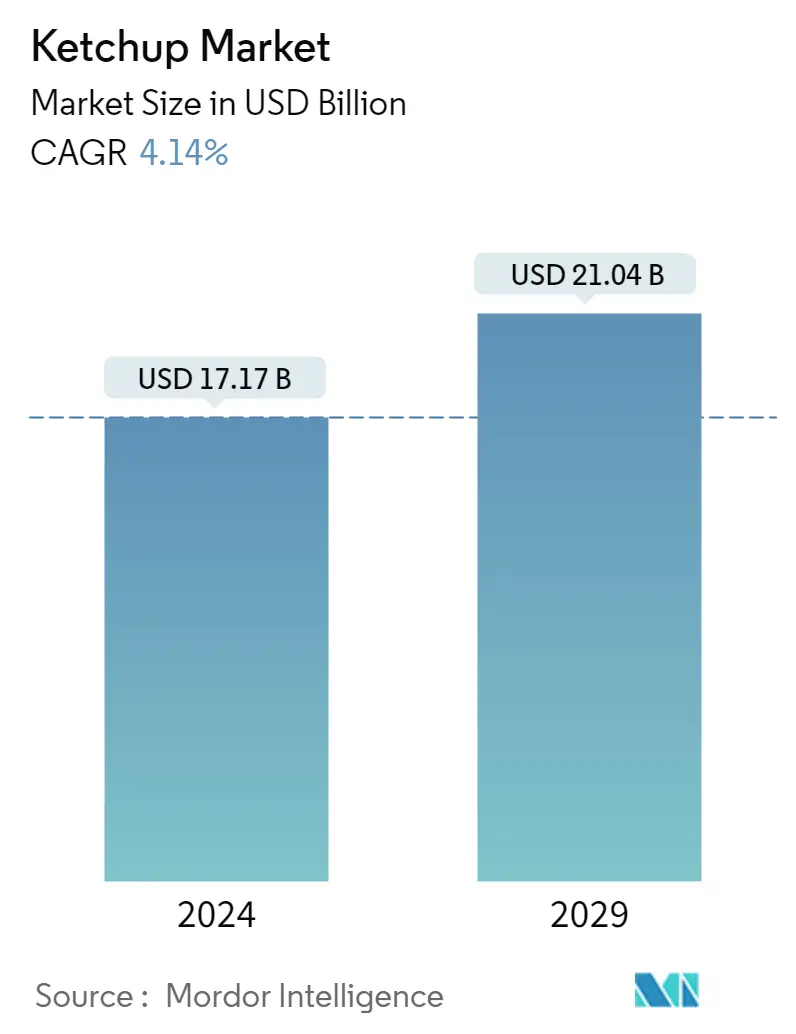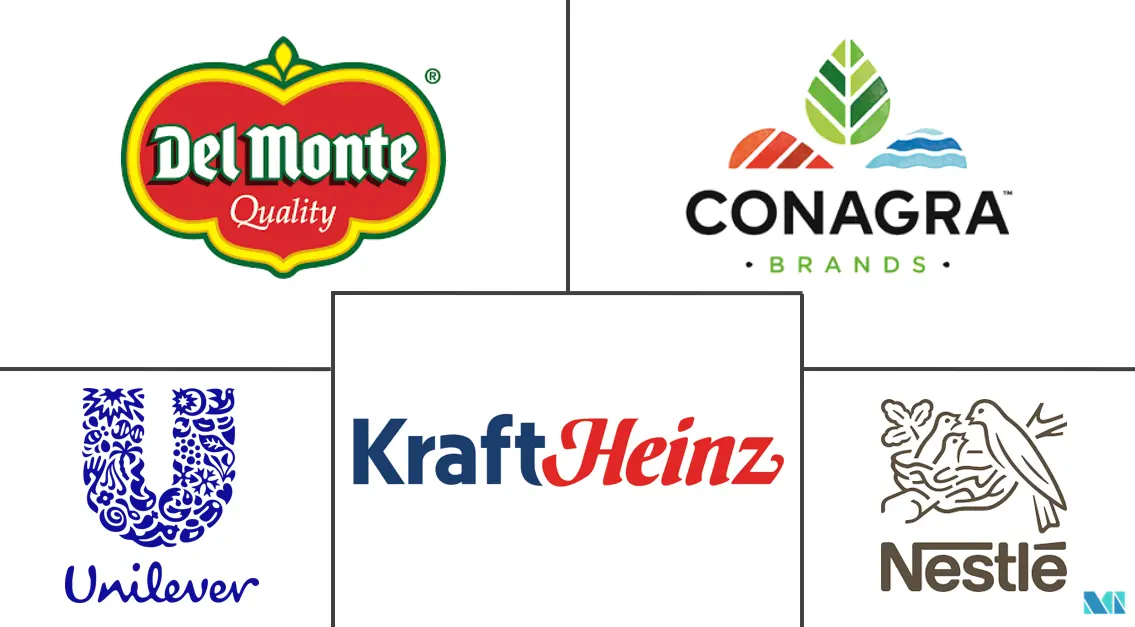Market Size of Ketchup Industry

| Study Period | 2019 - 2029 |
| Market Size (2024) | USD 17.17 Billion |
| Market Size (2029) | USD 21.04 Billion |
| CAGR (2024 - 2029) | 4.14 % |
| Fastest Growing Market | Asia Pacific |
| Largest Market | North America |
| Market Concentration | Low |
Major Players
*Disclaimer: Major Players sorted in no particular order |
Ketchup Market Analysis
The Ketchup Market size is estimated at USD 17.17 billion in 2024, and is expected to reach USD 21.04 billion by 2029, growing at a CAGR of 4.14% during the forecast period (2024-2029).
- The rising urbanization levels and the increasing disposable income have led many individuals to opt for on-the-go food. These food types are rapidly gaining popularity, especially among Generation Z and the millennials. Ketchup is a vital food item used across many fast-food types. Thus, these factors are likely to bring tremendous growth opportunities for the ketchup market in the coming years.
- Additionally, consumers' increasing preference for organic food, including ketchup, is driving the growth of the market. For instance, according to the Organic Trade Association, the sales of organic food amounted to approximately USD 57.5 billion in 2021 in the United States. Their growing concerns about the possible health risks of consuming artificial additives and genetically modified organisms (GMOs) have accelerated the consumption of sauces and condiments labeled as natural, organic, and non-GMO.
- Private-label ketchup brands have been performing better than well-established brands in many countries, such as the United Kingdom, France, Germany, and others. The major players are focused on providing new varieties to cater to changing consumer demands.
Ketchup Industry Segmentation
Ketchup is a sweet and tangy sauce usually made with tomatoes, sweeteners, vinegar, salt, various seasonings, spices, and other additives and is a very popular condiment.
The ketchup market is segmented by product type, packaging, distribution channel, and geography. Based on product type, the market is segmented into regular ketchup and flavored ketchup. Based on packaging, the market is segmented into bottled and pouch. Based on the distribution channel, the market is segmented into on-trade and off-trade channels. The on-trade channel comprises food service channels, while off-trade is further segregated into supermarkets/hypermarkets, convenience stores, online retail stores, and other distribution channels. Based on geography, the market segments are North America, Europe, Asia-Pacific, South America, and Middle-East & Africa.
For each segment, the market sizing and forecasts have been done on the basis of value (in USD million).
| Product Type | |
| Regular Ketchup | |
| Flavored Ketchup |
| Packaging | |
| Bottled | |
| Pouch |
| Distribution Channel | ||||||
| On-trade (Foodservice) | ||||||
|
| Geography | ||||||||
| ||||||||
| ||||||||
| ||||||||
| ||||||||
|
Ketchup Market Size Summary
The ketchup market is poised for significant growth, driven by increasing urbanization and rising disposable incomes that encourage on-the-go food consumption, particularly among younger generations like Generation Z and millennials. Ketchup's integral role in fast food and its growing demand for organic variants are key factors propelling market expansion. Consumers are increasingly favoring products labeled as natural, organic, and non-GMO due to health concerns over artificial additives. This shift has led to a surge in private-label brands outperforming established ones in various regions, as major players innovate to meet evolving consumer preferences. Companies like Kraft Heinz, Annie's Homegrown, and Orchard Lane are at the forefront, responding to the demand for organic ketchup with new product offerings and strategic acquisitions, such as Unilever's purchase of Sir Kensington.
North America holds a substantial share of the ketchup market, supported by the region's abundant tomato supply and consumer preference for ketchup over other condiments. The market's growth is further fueled by changing dietary habits and the increasing popularity of fast food. The ketchup market is highly competitive and fragmented, with leading companies like Del Monte Foods, Kraft Heinz, Conagra Brands, Nestlé, and Unilever leveraging distribution networks and online channels to expand their reach. Innovations in product offerings and sustainable packaging, such as Heinz's paper-based bottle and the Marz Edition ketchup, highlight the industry's focus on meeting consumer demands and environmental concerns.
Ketchup Market Size - Table of Contents
-
1. MARKET DYNAMICS
-
1.1 Market Drivers
-
1.2 Market Restraints
-
1.3 Porter's Five Forces Analysis
-
1.3.1 Threat of New Entrants
-
1.3.2 Bargaining Power of Buyers/Consumers
-
1.3.3 Bargaining Power of Suppliers
-
1.3.4 Threat of Substitute Products
-
1.3.5 Intensity of Competitive Rivalry
-
-
-
2. MARKET SEGMENTATION
-
2.1 Product Type
-
2.1.1 Regular Ketchup
-
2.1.2 Flavored Ketchup
-
-
2.2 Packaging
-
2.2.1 Bottled
-
2.2.2 Pouch
-
-
2.3 Distribution Channel
-
2.3.1 On-trade (Foodservice)
-
2.3.2 Off-trade
-
2.3.2.1 Supermarkets/Hypermarkets
-
2.3.2.2 Convenience Stores
-
2.3.2.3 Online Retail Stores
-
2.3.2.4 Other Off-trade Channels
-
-
-
2.4 Geography
-
2.4.1 North America
-
2.4.1.1 United States
-
2.4.1.2 Canada
-
2.4.1.3 Mexico
-
2.4.1.4 Rest of North America
-
-
2.4.2 Europe
-
2.4.2.1 Spain
-
2.4.2.2 United Kingdom
-
2.4.2.3 Germany
-
2.4.2.4 France
-
2.4.2.5 Italy
-
2.4.2.6 Rest of Europe
-
-
2.4.3 Asia-Pacific
-
2.4.3.1 China
-
2.4.3.2 Japan
-
2.4.3.3 India
-
2.4.3.4 Australia
-
2.4.3.5 Rest of Asia-Pacific
-
-
2.4.4 South America
-
2.4.4.1 Brazil
-
2.4.4.2 Argentina
-
2.4.4.3 Rest of South America
-
-
2.4.5 Middle-East and Africa
-
2.4.5.1 South Africa
-
2.4.5.2 United Arab Emirates
-
2.4.5.3 Rest of Middle-East and Africa
-
-
-
Ketchup Market Size FAQs
How big is the Ketchup Market?
The Ketchup Market size is expected to reach USD 17.17 billion in 2024 and grow at a CAGR of 4.14% to reach USD 21.04 billion by 2029.
What is the current Ketchup Market size?
In 2024, the Ketchup Market size is expected to reach USD 17.17 billion.

